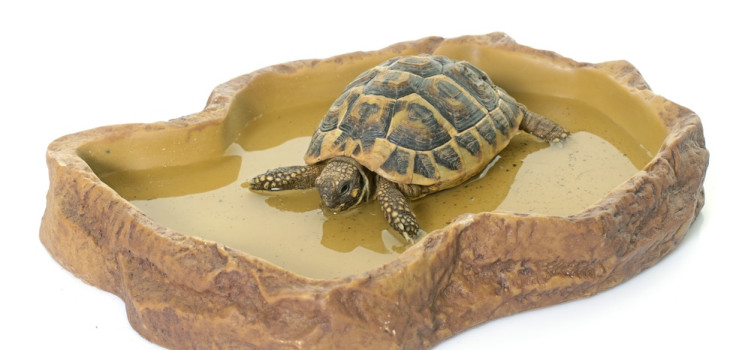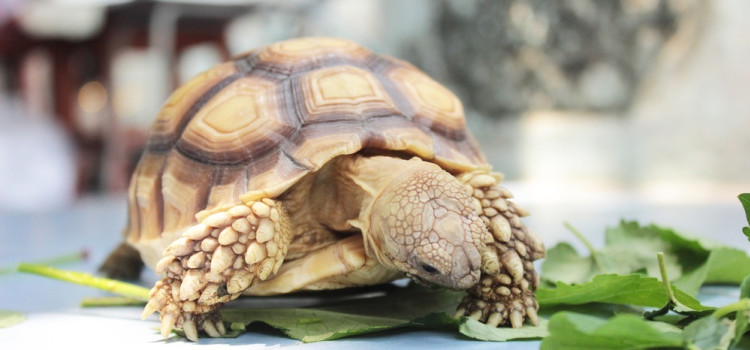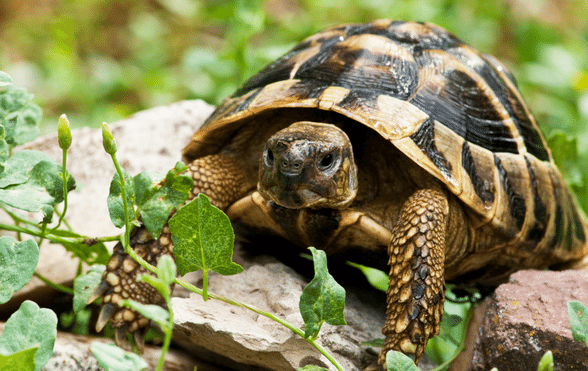Learn why your tortoise may not be eating and the importance of Calcium and Vitamin D3 in your tortoises diet.
Get a quote to insure your tortoise for £2,500 of vet fees, death and theft | Vet fee cover only also available | 95% of claims paid between Jan – October 2019 | Specialist exotic pet insurers since 1996 | Read our customer reviews on Feefo
My tortoise isn’t eating
Also known as ‘Anorexia’ a tortoise not eating is potentially serious. It can be a sign of either poor management or illness, but what is certain is that unless the cause is identified and corrected, then your pet’s health will be on a downward spiral.
-
- Emerging from hibernation and dehydration: When a tortoise first emerges from hibernation it may well show little interest in food for the first few days, until it has had a drink and is fully rehydrated again.
This is quite normal behaviour, but the aim as always should be to rekindle your pet’s appetite as quickly as possible. The type of food offered at this stage can be significant, with tortoises usually being more inclined to take foods such as tomato that are juicy, having a high water content, rather than a dry pelleted food.
You may like to read: Tortoises waking up from hibernation
- Stomatitis: Another reason linked with hibernation as to why tortoises fail to eat is a mouth infection, known as stomatitis. This results in pale yellow deposits here, and if untreated, these can easily extend down the throat, with the condition becoming more serious.
Rapid veterinary treatment will be required to overcome this illness, which is similar to ‘mouth rot’ seen in snakes.
- Respiratory infection: If tortoises have a respiratory infection of any type, which may be manifested by a slight bubbling from the nostrils, then they are also likely to ignore any food on offer.
- Emerging from hibernation and dehydration: When a tortoise first emerges from hibernation it may well show little interest in food for the first few days, until it has had a drink and is fully rehydrated again.
- Intestinal parasites: It is always worthwhile having your tortoise’s droppings monitored for signs of intestinal parasites, particularly as a heavy worm infestation can easily depress a tortoise’s appetite, and the cause will not be immediately apparent.
It may be worth doing this twice a year, during the early summer and then again in the autumn, before your pet enters hibernation.
Treatment can then be given as necessary, but it can be difficult to prevent reinfection, with the microscopic worm eggs being present in the tortoise’s environment.
Thorough cleaning of your tortoise’s housing can help if it is living indoors, but outside in the garden eliminating these parasites is very difficult. Here you can try moving your pet to a different area of lawn perhaps, so that it is less likely to come into contact with them.
- Temperature: One of the most common reasons for pet tortoises losing their appetite is that their surroundings are too cold. The trend today is to keep young hatchlings on open tortoise tables, rather than in enclosed vivariums where the ventilation is more restricted and the temperature is higher.
Unfortunately, what can then happen with a tortoise table during the winter months is that the reptile’s surroundings are not warm enough to encourage it to eat properly, especially during the day when the room heating may be off.
When setting up a tortoise table, always create a suitable thermal gradient, running from one end to another, so that the tortoise will always be able to thermo-regulate, adjusting its location according to its temperature needs. You should use a basking lamp as your heat source.
A likely sign that your pet is cold will be if it spends all its time under the basking lamp, and is reluctant to use the rest of its enclosure.
You can check the temperature in different parts of the enclosure very easily by using a suitable temperature gun for this purpose.
- Doesn’t like his food: There is always the possibility that the tortoise may simply not like or recognise its food. This was a problem when commercially prepared diets were first introduced, as tortoises did not find the pellets very appetising, although this issue has now been largely overcome now.
Calcium in your tortoises food
As far as tortoises – and especially young tortoises – are concerned, the calcium level of the food is very important, both for healthy bone and shell development, as well as the eggshells of laying females.
Dandelions are a significant source of calcium and are important for this reason. They are also generally very popular with tortoises who will eat the flowers as well as the leaves.
Other similar plants such as milk thistle can also form a significant part of their diet.
The importance of calcium
This mineral is also important in other ways too, at cellular level, in the transmission of nerve impulses for example.
There are various ways to supply calcium, including the provision of pieces of cuttlebone, as more usually sold in pet stores for birds such as budgerigars. You can simply break this up into pieces, making it easier for your tortoise to eat.
If you live in an area where the soil is chalky, you may also notice that your tortoise occasionally picks up small pieces of chalk and swallows these. This is nothing to worry about, being a reflection of your pet’s natural behaviour.
The distribution of Mediterranean tortoises is quite closely matched to that of limestone/chalky areas across their range, guaranteeing them a supply of calcium carbonate literally under their feet.
Ensure you provide the correct kind of UV lighting so that your tortoise can metabolise the calcium you provide him.
Insure your tortoise for £2,500 of vet fees, death and theft | Vet fee cover only also available
Alternatively you can call us on 0345 982 5505
Calcium and vitamin supplements for your Tortoise
You can also use calcium supplements to sprinkle over the tortoise’s food, by way of a supplement. Recent research has suggested that calcium carbonate combined with magnesium carbonate may be most effective, and products of this type are now available, rather than a simple calcium supplement.
In combination with this a general vitamin and mineral powder is also recommended too. Always follow the on-pack instructions regarding use in order to ensure that your tortoise is not given too much, as this could be harmful particularly over a period of time.
You may like to read: Tortoise Care Essentials
How often should you give your tortoise vitamin and mineral supplements?
As a guide, a vitamin and mineral supplement is typically used for a tortoise once or twice a week.
A supplement of this type is typically alternated with calcium on the other days of the week, but for specific advice regarding a supplement schedule for your pet, please refer to a vet who specialises in reptiles.
There are a number of variables to consider, including the housing, diet, age and reproductive status of your tortoise that must be borne in mind.
The importance of Ultraviolet (UV) light and Vitamin D3 for your tortoise
In order to absorb the calcium into the body so it can be utilised a source of vitamin D3 is essential for a tortoise.
In the case of tortoises roaming outdoors, they are normally exposed to sunlight. The ultra violet (UV) rays falling on the skin trigger the creation of this form of the vitamin here.
Especially in the case of tortoises being kept indoors though, an alternative arrangement will be required, since UV will not enter a room through ordinary window glass.
This can be achieved through the use of a suitable UV reptile light suspended over the tortoise’s housing so it can bask under and benefit from this light. Be sure to purchase a reputable brand, rather than an unbranded version on the web, that may be potentially dangerous to use.
The UV source will need changing after approximately 10-12 months, in accordance with the manufacturer’s instructions. This is because even though it may still be working, its beneficial UV output will have declined significantly by this stage.
You may like to read Tortoise food and diet advice
Your tortoise and water
Contrary to popular belief, tortoises do drink, and should have access to a fresh supply of water at all times.
A large, shallow container is recommended for this purpose. This should give a tortoise easy access, without the risk of the reptile becoming trapped.
It also needs to be relatively heavy as well, so that it will not be tipped over by your pet. Suitable containers of this type can be found in reptile outlets.
A tortoise’s need for water is often most evident in the case of Mediterranean species when they first emerge from hibernation.
A shallow bath in slightly warm water, once or perhaps even twice a day for 10 minutes or so at this stage, is to be recommended. This will not only rehydrate the reptile, but also helps it to open its eyelids, which is important in terms of persuading your pet to start eating again.

What would you do if you were faced with a high vet bill? We can cover tortoises for up to £2,500 of vet fees.
Alternatively you can call us on 0345 982 5505
Strange tastes
These reptiles are surprisingly adept at eating just what they want, being able to extricate some sprigs of a plant out of a clump of grass for example without difficulty.
This is achieved by means of their surprisingly flexible neck and forelegs, which can be used to hold plants down, making them easier to bite.

Tortoises use their feet and jaws very effectively in combination to eat the food that they want. Photo courtesy Kongkiat Charoensawat/www.shutterstock.com
When housed indoors though, there is a risk that a tortoise’s food will become contaminated by the substrate. Sand for example, may stick to damp plant matter and then ends up being swallowed. Over time this could accumulate in the tortoise’s digestive tract, giving rise to a blockage or impaction.
It is therefore recommended to use a large feeding dish, and avoid substrates of this type.
As mentioned, however, tortoises may seek out and swallow small pieces of chalk from a flowerbed for example, as a means of supplementing their calcium intake.
This is quite normal, but should not occur if you are using a calcium supplement. Tortoises will sometimes hunt garden snails for the same reason, seeking the calcium present in their shells.
Occasionally, they may engage in coprophagy, eating their droppings, or those of other animals. The reason for this is less clear-cut, but it may be linked to a deficiency of B vitamins in their diet. Hopefully, a suitable supplement will help to overcome the problem, but a worm check is also a good idea, as these internal parasites can easily be spread by this behaviour.
Weighing your tortoise
Finally, it’s important to have a pair of scales that you can use exclusively to weigh your tortoise regularly on a fortnightly or monthly basis, as this is the best way to keep a check on its condition.
Note the figures down, and you can compare them with the ideal weight online, by looking at Jackson or McIntyre ratio charts, depending on which species of European tortoise you are keeping.
Insure your tortoise for £2,500 of vet fees, death and theft | Vet fee cover only also available | 95% of claims paid between Jan – October 2019 | Specialist exotic pet insurers since 1996 | Read our customer reviews on Feefo
Alternatively you can call us on 0345 982 5505
-
- Disclaimer
Should you choose to follow advice given in this article, you do so at your own risk. Advice offered is not a substitute for professional vet advice.

